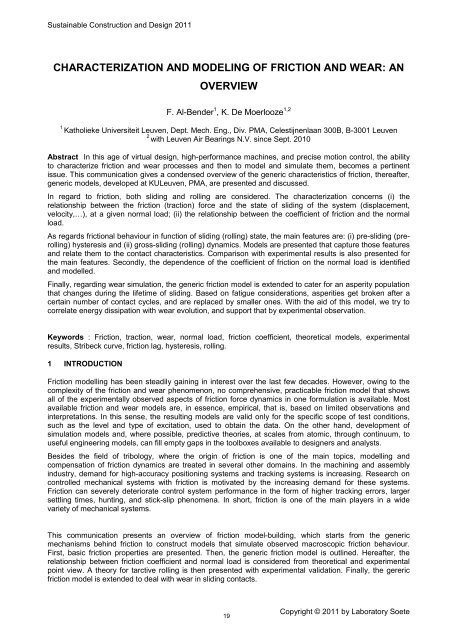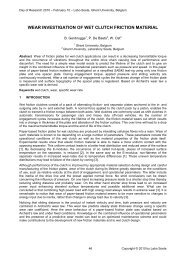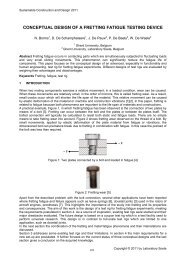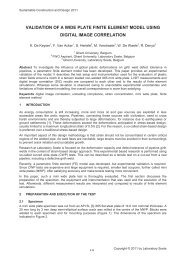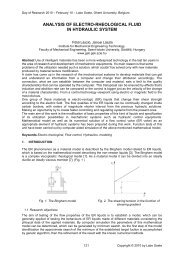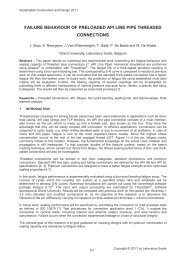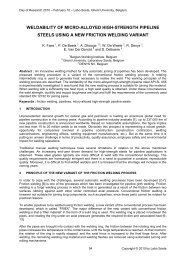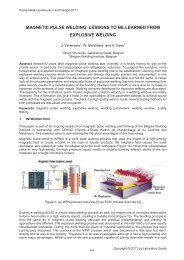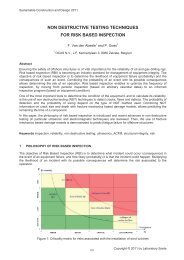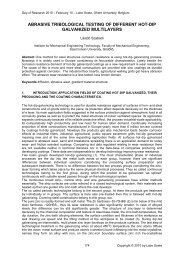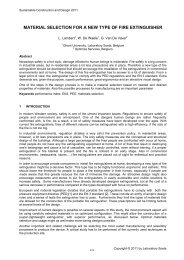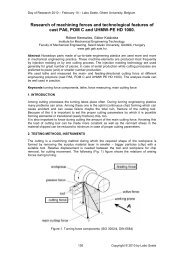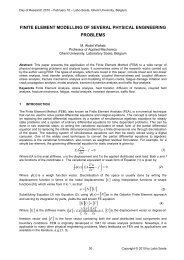Volume 2, Issue 1, 2011, Full Text - 5th International Conference on ...
Volume 2, Issue 1, 2011, Full Text - 5th International Conference on ...
Volume 2, Issue 1, 2011, Full Text - 5th International Conference on ...
You also want an ePaper? Increase the reach of your titles
YUMPU automatically turns print PDFs into web optimized ePapers that Google loves.
Sustainable C<strong>on</strong>structi<strong>on</strong> and Design <str<strong>on</strong>g>2011</str<strong>on</strong>g><br />
CHARACTERIZATION AND MODELING OF FRICTION AND WEAR: AN<br />
OVERVIEW<br />
F. Al-Bender 1 , K. De Moerlooze 1,2<br />
1<br />
Katholieke Universiteit Leuven, Dept. Mech. Eng., Div. PMA, Celestijnenlaan 300B, B-3001 Leuven<br />
2<br />
with Leuven Air Bearings N.V. since Sept. 2010<br />
Abstract In this age of virtual design, high-performance machines, and precise moti<strong>on</strong> c<strong>on</strong>trol, the ability<br />
to characterize fricti<strong>on</strong> and wear processes and then to model and simulate them, becomes a pertinent<br />
issue. This communicati<strong>on</strong> gives a c<strong>on</strong>densed overview of the generic characteristics of fricti<strong>on</strong>, thereafter,<br />
generic models, developed at KULeuven, PMA, are presented and discussed.<br />
In regard to fricti<strong>on</strong>, both sliding and rolling are c<strong>on</strong>sidered. The characterizati<strong>on</strong> c<strong>on</strong>cerns (i) the<br />
relati<strong>on</strong>ship between the fricti<strong>on</strong> (tracti<strong>on</strong>) force and the state of sliding of the system (displacement,<br />
velocity,…), at a given normal load; (ii) the relati<strong>on</strong>ship between the coefficient of fricti<strong>on</strong> and the normal<br />
load.<br />
As regards fricti<strong>on</strong>al behaviour in functi<strong>on</strong> of sliding (rolling) state, the main features are: (i) pre-sliding (prerolling)<br />
hysteresis and (ii) gross-sliding (rolling) dynamics. Models are presented that capture those features<br />
and relate them to the c<strong>on</strong>tact characteristics. Comparis<strong>on</strong> with experimental results is also presented for<br />
the main features. Sec<strong>on</strong>dly, the dependence of the coefficient of fricti<strong>on</strong> <strong>on</strong> the normal load is identified<br />
and modelled.<br />
Finally, regarding wear simulati<strong>on</strong>, the generic fricti<strong>on</strong> model is extended to cater for an asperity populati<strong>on</strong><br />
that changes during the lifetime of sliding. Based <strong>on</strong> fatigue c<strong>on</strong>siderati<strong>on</strong>s, asperities get broken after a<br />
certain number of c<strong>on</strong>tact cycles, and are replaced by smaller <strong>on</strong>es. With the aid of this model, we try to<br />
correlate energy dissipati<strong>on</strong> with wear evoluti<strong>on</strong>, and support that by experimental observati<strong>on</strong>.<br />
Keywords : Fricti<strong>on</strong>, tracti<strong>on</strong>, wear, normal load, fricti<strong>on</strong> coefficient, theoretical models, experimental<br />
results, Stribeck curve, fricti<strong>on</strong> lag, hysteresis, rolling.<br />
1 INTRODUCTION<br />
Fricti<strong>on</strong> modelling has been steadily gaining in interest over the last few decades. However, owing to the<br />
complexity of the fricti<strong>on</strong> and wear phenomen<strong>on</strong>, no comprehensive, practicable fricti<strong>on</strong> model that shows<br />
all of the experimentally observed aspects of fricti<strong>on</strong> force dynamics in <strong>on</strong>e formulati<strong>on</strong> is available. Most<br />
available fricti<strong>on</strong> and wear models are, in essence, empirical, that is, based <strong>on</strong> limited observati<strong>on</strong>s and<br />
interpretati<strong>on</strong>s. In this sense, the resulting models are valid <strong>on</strong>ly for the specific scope of test c<strong>on</strong>diti<strong>on</strong>s,<br />
such as the level and type of excitati<strong>on</strong>, used to obtain the data. On the other hand, development of<br />
simulati<strong>on</strong> models and, where possible, predictive theories, at scales from atomic, through c<strong>on</strong>tinuum, to<br />
useful engineering models, can fill empty gaps in the toolboxes available to designers and analysts.<br />
Besides the field of tribology, where the origin of fricti<strong>on</strong> is <strong>on</strong>e of the main topics, modelling and<br />
compensati<strong>on</strong> of fricti<strong>on</strong> dynamics are treated in several other domains. In the machining and assembly<br />
industry, demand for high-accuracy positi<strong>on</strong>ing systems and tracking systems is increasing. Research <strong>on</strong><br />
c<strong>on</strong>trolled mechanical systems with fricti<strong>on</strong> is motivated by the increasing demand for these systems.<br />
Fricti<strong>on</strong> can severely deteriorate c<strong>on</strong>trol system performance in the form of higher tracking errors, larger<br />
settling times, hunting, and stick-slip phenomena. In short, fricti<strong>on</strong> is <strong>on</strong>e of the main players in a wide<br />
variety of mechanical systems.<br />
This communicati<strong>on</strong> presents an overview of fricti<strong>on</strong> model-building, which starts from the generic<br />
mechanisms behind fricti<strong>on</strong> to c<strong>on</strong>struct models that simulate observed macroscopic fricti<strong>on</strong> behaviour.<br />
First, basic fricti<strong>on</strong> properties are presented. Then, the generic fricti<strong>on</strong> model is outlined. Hereafter, the<br />
relati<strong>on</strong>ship between fricti<strong>on</strong> coefficient and normal load is c<strong>on</strong>sidered from theoretical and experimental<br />
point view. A theory for tarctive rolling is then presented with experimental validati<strong>on</strong>. Finally, the gereric<br />
fricti<strong>on</strong> model is extended to deal with wear in sliding c<strong>on</strong>tacts.<br />
19<br />
Copyright © <str<strong>on</strong>g>2011</str<strong>on</strong>g> by Laboratory Soete


